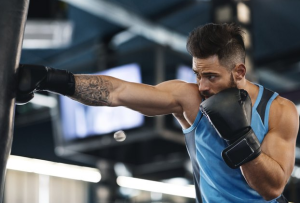The punch boxing machine calculates metrics like punch power, velocity, accuracy, and energy transfer. For example, a punch at 12 meters/second and 80% accuracy may score 500. Improving speed to 15 meters/second and accuracy to 90% can raise the score to 650.
Table of Contents
TogglePunch Power
Boxing punch machines do measure the punch power and provide concrete ways to develop physical strength, speed, and accuracy. Scores range from 200 to 400 on average with casual users, while people in better physical condition can score over 500. Scores of above 800 are usually obtained by professional athletes and amateur boxers, with elite punchers reaching scores up to 1,200. For example, a decently strong amateur who weighs 70 kg can easily develop sets in the range of 600-700, while a novice of the same weight might only be able to attain 300-400 due to lack of skill and speed. These differences show how physical attributes and technique complement each other in determining punching power.
Speed largely determines the power of a punch. A punch that travels at 12 meters per second will have far more force than the one that travels at 8 meters per second. In fact, research has indicated that increasing punch velocity by just 25% can boost overall punching power by nearly 50%. For instance, a player who scores 400 with an average speed punch of 8 meters per second could increase their score to about 500 by increasing their speed to 10 meters per second. From this information, one learns that Emphasis should be on quick, explosive movements if one intends to increase his scores on a boxing punch machine.
Technique and energy transfer also play an important role in maximizing the power of a punch. One biomechanics study discovered that power output can be enhanced by as much as 30% through proper fist, wrist, and forearm alignment. Take one who scores 500 while using bad form; with a correction of the wrist and addition of hip rotation, he may attain closer to 650. Pragmatically, that means players often don’t need significant strength increases to greatly improve their scores, but rather more technical execution.

Impact Velocity
Impact velocity represents the velocity at which the punch lands on the target of a boxing punch machine; it therefore represents the momentum through which power and effectiveness can be determined. Average players normally create a punch velocity of 6 to 10 meters per second and thereby generate a score in the moderate range of 200 to 400. Experienced players or athletes easily exceed velocities beyond 12 meters per second, taking their score beyond 700. For example, where the player can attain a velocity of 8 meters per second, he gets a score of 350; by increasing his speed to 10 meters per second, he raises his score to around 450, showing the relationship to be exponential.
Studies have shown that for every 20% gain in velocity, there is an exponential gain in total punch force. For example, using a player whose impact velocity increases from 10 meters per second to 12 meters per second, this marginal gain could increase their score by 100-150 points on the machine. For instance, while the punch at 10 meters per second may create a force of 500 pounds and give a score of 600, raising the velocity to 12 meters per second can increase the force to as much as 700 pounds and bring the score close to 750. Such information reveals the importance of velocity in performance optimization.
The velocity of impact also depends on the punch being thrown. Because of their straighter motion and more linear direction, the straight punches, such as the jab and cross, have much higher velocities than either the hook or uppercuts. In one analysis of professional boxers, a well-delivered jab had a velocity of 15 meters per second, whereas an average hook seldom reached more than 12 meters per second. For instance, a player dependent on straight punches may witness their score increase by 20%, while a player relying on slower hooks may not achieve a similar score. This would show that understanding and optimizing punching techniques can translate directly into performance.

Accuracy
Accuracy on a boxing punch machine is a very critical factor that determines the efficiency of a good translation of a punch to a score. A strike in the very center maximizes energy transfer and ensures higher points. For casual players, the average accuracy rate is about 60-70%; therefore, their punches often fall off-center, which means a reduced score. For instance, if a punch can record 500 pounds with only 60% accuracy, it will only score 300 points. The same force applied with 90% accuracy will result in a score of 450. This shows how significant the difference precision can make in performance.
Top-rated players are able to achieve accuracy rates of 90-95%, thus producing more regular and high scores. Data from competitive scenarios reveals that an average punch with 800 pounds of force combined with 95% accuracy gives scores above 750, whereas even a strong punch of 1,000 pounds with only 70% accuracy can score around 700. The difference in this respect is that the power alone cannot provide victory; precision multiplies the effect and ensures effective energy delivery to the target area.
Training specifically for accuracy can yield remarkable improvements. Regular exercise, focusing on targeting specific zones of the punching pad, improves precision over time. In one study of player performance, players who spent 10 minutes daily practicing on a smaller striking surface improved their accuracy from 70% to 85% within a month. This may easily increase an individual’s score, for example, from 400 to 480, merely by the ability to get their punches closer to the center of the target. This consistent improvement shows the value of targeted accuracy drills.

Energy Transfer
Energy transfer is the most important factor in accomplishing high scores in the boxing punch machine. This means the rate at which force from your punch is transferred to the target of a machine. In average, most players achieve an energy transfer efficiency of around 60-70%, with about 30-40% lost out of force in the punch to unmanaged or badly timed strikes or misaligned techniques. For example, if a player produces 500 pounds of force, but is only transferring 65%, then the machine may only be registering 325 pounds. If that can be increased to 90% transfer, the score would then be 450, which shows how important this factor is in maximizing results.
Good energy transfer comes from good form. Proper alignment of the wrist, fist, and arm can result in as much as a 25% gain in efficiency for the player. For instance, a study conducted on novice players showed that correcting their punching posture increased their average scores from 300 to 375 without necessarily increasing punch strength. This implies that most times, perfecting the technique is far more helpful than toning or strengthening the muscles. A professional-level player with optimized energy transfer can deliver almost 95% of the force to the target and always scores top, upwards of 800 or so.
Speed also enhances the energy transfer because of minimum time of impact. When punches are delivered with higher velocity, then the chance of dissipation reduces, so their energy transfer tends to be good. For example, a punch with the speed of 12 meters per second and the force of 700 pounds could achieve a score of 630 if energy transfer is at 90%, while a slower punch at 10 meters per second might only be transferring 75% of its energy, resulting in a significantly lower score of 525. This shows how a combination of speed and form contributes to better energy transfer.
Punch Type
Also, the type of punch plays a significant role in the attainment of scores on a boxing punch machine since different types of punches deliver various levels of power, speed, and energy transfer. Straight-line punches like jabs and crosses tend to result in higher scores due to the directness of such punches while efficient energy delivery occurs. That is, for example, a jab with proper form and having a force of 600 pounds can score up to 550 points, while a hook, even at the same force, might only score about 450 points due to its angular trajectory and energy loss. Uppercuts can score the same way as hooks but need more precision in targeting for maximum efficiency.
Data comparisons show significant differences in the performance metrics of various punch types. Jabs and crosses, when executed correctly, have an average impact velocity of 12-15 meters per second and an energy transfer efficiency of up to 90%. In contrast, hooks and uppercuts, while often stronger in raw force, usually achieve impact velocities of 10-12 meters per second and energy transfer efficiencies closer to 75-80%. For instance, for a cross with 90% efficiency at a velocity of 14 meters per second, a player may score 650, whereas for a hook with the same player at 75% efficiency and at a velocity of 12 meters per second, the score can be only 500.
Different types of punches can be perfected with proper training and practice. Players who work on their hooks and uppercuts through shadowboxing drills and heavy bag work can increase their energy transfer efficiency up to 15%. For example, a beginner scoring 400 with the hook due to poor technique might start to have a score of 460 after targeted training in one month. For the jabs and crosses, improvements will be small because these punch types start out with generally higher efficiency and speed. This shows how important variety in practice for each type of punch can be.
Reaction Time
The data from competitive settings indicates a general rule of thumb: for every 50 milliseconds shaved off the reaction time, scores increase by about 10-15%. For example, a player scoring 450 with a reaction time of 250 milliseconds could see their new score increase to around 510 or more as the reaction time drops to 200 milliseconds. This is because with quicker reaction times, the punches can be aligned with peak momentum better, optimizing energy transfer and impact velocity.
Training to improve reaction time can be very effective. Such exercises include reflex drills, speed bag practice, and reaction lights; they decrease reaction times by 20-30 milliseconds in just a few weeks. For instance, a novice making 300 with a 300-millisecond reaction time may drop his reaction time down to 270 milliseconds and surge his score to 330 after some diligent training. These exercises sharpen neural connections and improve muscle memory, enabling players to respond to stimuli more effectively.
Punch Consistency
Punch consistency refers to a player’s ability to deliver repeated punches with minimal variation in power, accuracy, and speed, a crucial factor for maximizing scores on a boxing punch machine. Data shows that casual players often have a punch consistency rate of 50-60%, with power outputs fluctuating widely between punches. For example, a player might record a punch power of 450 on their first attempt but drop to 350 on subsequent punches due to fatigue or lack of rhythm. In contrast, trained players maintain consistency rates of 80-90%, ensuring their scores remain high and stable across multiple attempts.
Studies reveal that punch consistency can directly affect overall performance. Players who maintain consistent power within a 10% range score approximately 20-30% higher than those with greater variability. For instance, a player delivering punches with a consistent range of 400-440 pounds might average a score of 420. However, if the same player’s power fluctuates between 300 and 500 pounds, their average score might drop to around 380. This highlights how stability, rather than peak performance, often determines success over a series of punches.
Training to improve punch consistency requires focusing on endurance and rhythm. Exercises such as interval punching on heavy bags and timed combinations can help players maintain power output over extended sessions. For example, a beginner scoring inconsistently between 250 and 400 pounds could narrow their range to 300-350 pounds after one month of focused training, resulting in a more reliable average score of 325. This improvement is particularly beneficial for players competing for the highest cumulative scores, where every punch counts.



